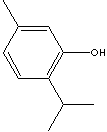PRODUCT IDENTIFICATION

H.S. CODE
TOXICITY
SMILES
CLASSIFICATION
Antiinfective, Antifungal, Pharmaceutic aid (stabilizer), Biochemicals ex Plants
PHYSICAL AND CHEMICAL PROPERTIES
5.2
REFRACTIVE INDEX
102 C
GENERAL DESCRIPTION & EXTERNAL LINKS
|
|
Menthol (Peppermint Camphor): ) a white crystalline compound with a characteristic pungent odor; freely soluble in alcohols, ether, and chloroform. It is obtained from mint oils (mainly peppermint) or made synthetically from coal tar. It exists in levo or dextro isomer forms. Menthol imparts a tingling sensation to the skin and used in skin fresheners like after-shave and suntan lotions. It has a local anesthetic property for short-term relief of minor sore throat and minor muscle aches. It is used in medicines and perfumes, and as a mint flavoring agent. End applications include toothpaste, cough drops, ice cream, chewing gum, shampoo, medical plaster.
Thymol (Thyme Camphor): a white crystals with camphor like odor, is a phenolic compound obtained naturally from thyme oil (or other volatile oils) or prepared synthetically. It is very slightly soluble in water; soluble in paraffin oil and alcohol. It is used as a stabilizer in pharmaceutical and as a topical antiseptic, antibacterial, and anti-fungal agent. It is also used as a flavoring agent for drugs (camphor, herbal, wintergreen,disinfectants, origanum )
Wikipedia Linking: http://en.wikipedia.org/wiki/Thymol
http://www.henriettesherbal.com/
.....Thymol, as described by the U. S. P., forms "large, colorless, translucent
crystals of the hexagonal system, having an aromatic, thyme-like odor, and a
pungent, aromatic taste, with a very slight caustic effect upon the lips. Its
specific gravity, as a solid, is 1.069 at 15° C. (59° F.), but when liquefied by
fusion it is lighter than water. It melts at 50° to 51° C. (122° to 123.8° F.),
remaining liquid at considerably lower temperatures. When triturated with about
equal quantities of camphor, menthol, or chloral, it liquefies. Soluble in about
1200 parts of water at 15° C. (59° F.), and in less than its own weight of
alcohol, ether, or chloroform; also readily soluble in carbon disulphide,
glacial acetic acid, and in fixed or volatile oils. Its alcoholic solution is
optically inactive"-(U. S. P.). Being a phenol, thymol readily dissolves in
caustic alkalies and is regenerated by acids, even carbonic acid (see
Preparation, above). Thymol also dissolves in 120 parts of glycerin. In
making solutions of thymol with glycerin and water, it is best to triturate the
thymol in a mortar with a small portion of alcohol, until it is dissolved, then
add the desired menstruum. Thymol boils at 230° C. (446° F.) (Doveri and
Lallemand)......
http://www.thirdplanetfood.com/
Thymol is a phenolic compound found in thyme oil, ajowan seeds (also called
ajwain or carom), and horsemint. It is an isomer of carvacrol, meaning it has
the same molecular formula but the atoms are arranged differently. Thyme is
widely used as an antibacterial, an antimicrobial and an antifungal. It is a
very effective disinfectant, being even better than carbolic acid. According to
the EPA it is also used in perfumes, food flavorings, mouth wash (Listerine) and
cosmetics. Some over the counter medications use thymol for acne, hemorrhoids
and athletes foot. It is a component of Vicks Vaporub, which has given many
people relief from foot fungus. Thymol was registered for use as a pesticide in the United States in 1964, to
be used for repelling domestic animals. It is also listed by the Food and Drug
Administration as a food additive, on the GRAS (Generally recognized as Safe)
list. According to an EPA Fact Sheet, they are not aware of any adverse effects of
thymol on humans or the environment, and haven't had any significant reports of
incidents with thymol....
http://www.botanical.com/
THYMOL, a most valuable crystalline phenol, is the basis of the fragrant
volatile Essence of Sweet Thyme, and is obtainable from Carum copticum,
Monarda punctata and various other plants, as well as from T.
vulgaris, being present to the extent of from 20 to 60 per cent in the oils
which yield it. Ajowan oil, its principal commercial source (from the seeds of
C. copticum) contains from 40 to 55 per cent of Thymol; the oil of T.
vulgaris contains from 20 to 30 per cent as a rule of Thymol and Carvacrol
in varying proportions, while the oil of M. punctata contains 61 per cent
of Thymol.
The extraction of Thymol is effected by treating the oil with a warm solution
of sodium hydroxide: this alkali dissolves the Thymol, and on dilution with hot
water the undissolved oil (terpenes, etc.) rises to the surface. The alkaline
thymol compound is decomposed by treatment with hydrochloric acid and subsequent
crystallization of the oily layer into large, oblique, prismatic crystals.
Thymol (methyl-propyl-phenol) has been prepared synthetically.
APPEARANCE
OTHER INFORMATION
FEMA # :3066